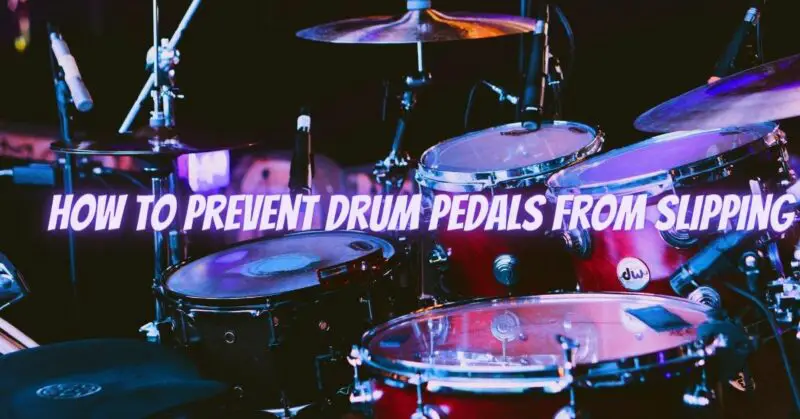As a drummer, maintaining a secure and stable drum pedal setup is crucial for precision, control, and overall performance. Dealing with pedal slippage can be frustrating and disruptive, compromising your playing experience. However, with a few simple techniques and adjustments, you can prevent drum pedal slippage and ensure a secure connection between your feet and the pedals. In this article, we will explore effective methods to keep your drum pedals in place and enhance your drumming experience.
- Proper Drum Rug or Mat: Investing in a drum rug or mat is an essential first step to prevent pedal slippage. These specialized mats provide a nonslip surface that helps anchor your drum pedals and keep them in place. Place the rug or mat under your drum kit, ensuring that it covers a sufficient area to accommodate your pedals and drum throne. This foundation provides stability and reduces movement during intense drumming sessions.
- Drum Anchor or Pedal Stabilizers: Drum anchors or pedal stabilizers are devices designed to secure drum pedals to the floor, minimizing slippage. They typically consist of metal or rubber clamps that attach to the base of the pedal and grip the carpet or mat underneath. These add-ons can greatly enhance stability and prevent the pedals from shifting during play. Consider investing in drum anchors or pedal stabilizers to secure your pedals firmly.
- Proper Pedal Placement: Correct placement of your drum pedals is crucial to prevent slippage. Ensure that the pedal’s base is aligned parallel to the drum rug or mat, allowing it to rest firmly on the surface. Position the pedals at a comfortable distance and angle, tailored to your playing style and ergonomic needs. Experiment with different pedal positions to find the most secure and comfortable setup for your feet.
- Utilize Velcro or Hook-and-Loop Strips: Velcro or hook-and-loop strips can provide an additional layer of security between your pedals and the drum rug or mat. Attach one side of the Velcro or hook-and-loop strips to the bottom of the pedal base and the corresponding side to the drum rug or mat. When pressed together, these strips create a strong connection, minimizing pedal slippage. Ensure that the strips are securely fastened to maintain their effectiveness.
- Pedal Chain or Strap Tension: Adjusting the tension of the pedal chain or strap can also help prevent slippage. Most drum pedals feature adjustable tension mechanisms that control the responsiveness and feel of the pedals. Experiment with different tension settings to find the balance between ease of play and pedal stability. A tighter tension can provide added security, but be mindful not to over-tighten, as it may affect your playing technique and speed.
- Clean and Maintain the Drum Rug or Mat: Regularly clean and maintain your drum rug or mat to maximize its grip and effectiveness. Remove dust, debris, and moisture from the surface to ensure optimal contact between the rug or mat and the pedal base. Vacuum or shake out the rug regularly, and use a damp cloth to wipe away any spills or dirt. A clean and well-maintained drum rug or mat will enhance its nonslip properties and prevent pedal slippage.
- Monitor Temperature and Humidity Levels: Extreme temperature and humidity fluctuations can impact the grip of your drum pedals. Avoid exposing your drum kit to extreme heat or cold, as it can affect the adhesive properties of the drum rug or mat. Maintain a controlled environment with moderate humidity levels to prevent excessive moisture buildup that may compromise the grip between the pedals and the rug or mat.
- Regular Pedal Maintenance: Perform regular maintenance on your drum pedals to ensure optimal functionality. Lubricate the moving parts, check for loose screws or bolts, and inspect the pedal springs for wear and tear. Well-maintained pedals operate smoothly, reducing the risk of slippage caused by mechanical issues.
- Monitor Footwear and Pedal Surface: Consider the footwear you use while drumming. Avoid wearing shoes with slippery soles or footwear that does not provide adequate traction. Opt for shoes with rubber soles or specialized drumming shoes that offer grip and stability. Additionally, periodically inspect the pedal surface for wear. If the surface becomes excessively smooth or worn, consider replacing it to maintain optimal grip.
Conclusion: Preventing drum pedal slippage is essential for drummers seeking precision, control, and an uninterrupted playing experience. By implementing these techniques, including using a drum rug or mat, utilizing drum anchors or pedal stabilizers, ensuring proper pedal placement, utilizing Velcro or hook-and-loop strips, adjusting pedal tension, maintaining cleanliness, monitoring temperature and humidity levels, conducting regular pedal maintenance, and selecting appropriate footwear, you can secure your drum pedals and minimize slippage. By creating a stable and reliable connection between your feet and the pedals, you can focus on your drumming skills, unleash your creativity, and confidently perform with consistency and control.

